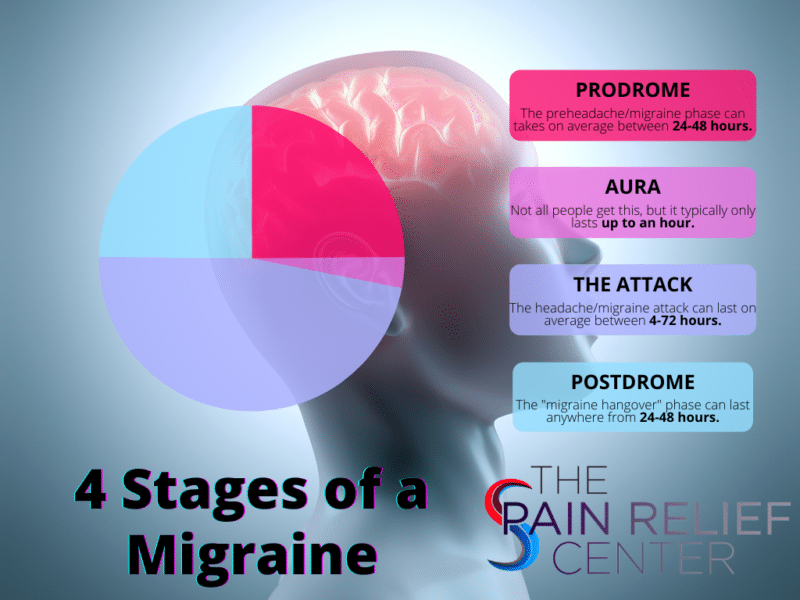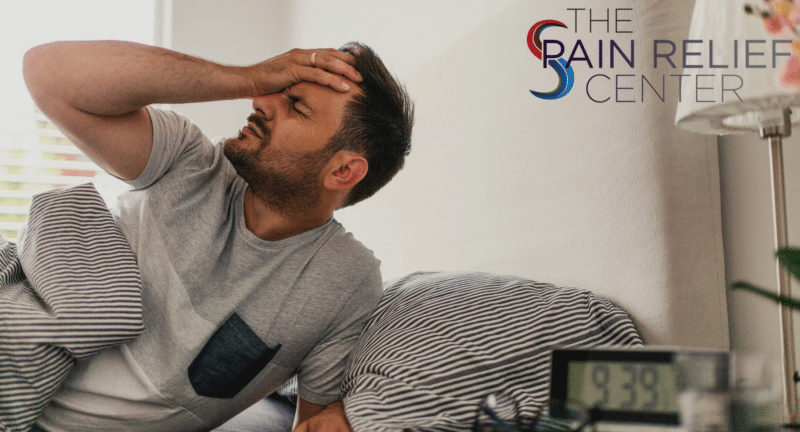What Is A Migraine?

A migraine attack is not a typical headache or head pain. Migraines are neurological diseases with varying symptoms from other headache disorders. The treatments for migraines also vary from other headache remedies. The migraine pain of other sufferers can vary in severity, origin, and suitable solutions. Migraine symptoms include intense sensitivity to light, repulsion by smells of certain foods, irritation to sounds, and even nausea or vomiting.
The main migraine attack symptom is debilitating and severe headaches and pain that prevent you from behaving as you naturally would. The throbbing or pulsing of a bad headache or migraine can become worse through triggers that overwhelm your senses. Migraine attacks have been known to last hours or days. Studies indicate that it is the 6th most incapacitating disorder in the world, and at least 12% of all Americans suffer from this genetic disease.
More on Migraine Facts here.
What Are The Types Of Headaches?
Headache pain is a very common and widespread problem that has been recognized for many years. To date, there have been more than 150 headache types identified. These headaches are separated into two classifications, which are: Primary headaches and Secondary headaches.
Primary headaches are clinical diagnoses, requiring no blood test or imaging to identify. A primary headache is not a symptom of an underlying disease or other health issues like Secondary headaches are.
If you are suffering from concerning migraines, read on and check out our other article on Migraine Doctor for Headaches.
Below are the 3 major primary headaches:
Tension-Type Headaches (TTH)
TTH is very common, and an estimated 3 quarters of the general population suffer from it. They have a great range from mild to debilitating. They are also known as tension headaches, muscle contraction headaches, and stress headaches. Studies on TTH have shifted from an original theory of them being caused by psychological factors to more physical and neurological. Tension-Type Headaches, though probably sensitive to light or sound, are usually not disabling. They allow the individual to complete tasks as needed. Sufferers don’t generally suffer from other symptoms such as nausea or vomiting.
TTH is further divided into:
Infrequent episodic type: <1 a month.
Frequent episodic type: 1<15 a month (or in less than 3 months)
Chronic tension-type: 15<+ each month (or per every 3 months)
Migraine Headache – With and Without Aura
On average, 15-20% of migraine sufferers experience an aura, and it is known as a complicated migraine. Common migraine attacks, without aura, strike quickly and without any warning signs that aura might provide. Common migraines and complicated migraines are the same in all ways except for the inclusion or exclusion of the aura phase prior to the migraine headaches. They can also be a chronic or episodic migraine, meaning you may suffer frequent or future attacks. We discuss auras in more depth below.
Click here to learn more about Treating And Coping With Chronic Pain.
Trigeminal Autonomic Cephalalgias (TACs) – Including Cluster Headaches and Paroxysmal Hemicrania
TACs are a Primary headache type that usually has pain that occurs unilaterally across the skull. They also tend to possess involuntary symptoms on the same side or region of the face, such as watery eyes, blood vessel dilation in the eye, or nasal symptoms.
How Do You Know If You’re Having A Migraine Attack?
The symptoms for migraine attacks usually vary per person, as does the severity and the individual’s capacity to function while suffering from one. However, there are some commonalities that help to identify if you are suffering from a migraine attack.
Imagine if you have had head pain for hours, and it has escalated from mild pain to moderate to severe pulsing pain. If the severe headache progresses often and impacts your ability to function in your daily goings, work, or school, you are likely undergoing a migraine attack. Migraine pain can shift from one or both sides (bilateral) of your head, forward or backward, like a band encircling the head, or feel like a vice grip. It can be centralized to the region behind or around your eyes or cheeks as well.
For some, migraines attacks result in other symptoms that are unpleasant, such as nausea, throwing up, and other sensitive sensory symptoms. A migraine with aura symptoms presents factors that disrupt the sufferer’s vision prior to the eruption of pain but typically last no longer than an hour before.
What Are The Four Stages Or Phases Of A Migraine?
Migraines are common neurological disorders that have a heavy impact on our day-to-day living. The distinct stages help us to understand our bodies better. Use a personal diary to track attacks, symptoms, occurrences, home remedies and compare it to any other possibly related factors. This can help determine what triggers migraines for you. The following will help you understand a little more about what these phases are and how they are distinct.
Prodrome:
The prodrome phase can endure for hours or days before an upcoming migraine. Not everyone has this stage, so it is possible to skip it entirely. During this pre-headache phase, subtle changes or warnings of a possible migraine could occur. Some of the prodrome symptoms for this premonitory phase include constipation, sharp mood shifts, food cravings, stiff neck, need for hydration, regular yawning, and more.
Aura:
Briefly mentioned before, an aura is a visual disturbance that gradually builds up due to the nervous system. It can occur before or during a migraine, or not at all. Most people do not experience it. They can persist anywhere from 20 minutes to an hour. It is possible for aura symptoms to not be visual. Examples of aura symptoms are loss of vision, bright spots, flashes in the vision, pins-and-needles sensations in limbs, numbness in a specific area, trouble speaking, noises or music that isn’t present, random or involuntary jerky movements, and more.
Headache/Migraine:
The migraine attack and headache phase can last anywhere from, on average, a few hours to 3 days. Despite the term “ache,” the pain of migraine attacks as they are usually very piercing or excruciating, even when deemed mild in comparison to more acute migraines or when a migraine lasts for a long time. People with migraine attacks may experience them rarely or on a more recurring basis, as well as in varying severity and symptoms. This is because migraines tend to affect every individual differently based on factors specific to the person, environment, and others.
If your migraine is severe, persistent, or has become concerning in any other way, please do not hesitate to talk to your healthcare provider or seek out a headache specialist. Get acute migraine treatments for any future migraine attacks from the Pain Relief Center in Dallas.
Postdrome:
The postdrome stage can last a day or more, known as the “migraine hangover,” and is on average experienced by 80% of migraine attack sufferers. During this time, the individual may feel weary, confused, exhausted, dehydrated, with body aches, or have mental fogginess, though some describe it as euphoria. But any sudden head movement may cause sharp pain again.
The last and distinct stage can still be just as enervating as other stages. In the event of transitioning from the attack stage to postdrome after a chronic or acute episode, the shift may be almost unnoticeable. It may feel as though the pain or other symptoms are simply spreading to the whole body to create stiffness and tenderness.
Staying hydrated, utilizing a cold compress, and staying in a dark and quiet room throughout the previous stages and this one will help this last stage conclude quicker and less uncomfortably. You should also avoid overstimulating triggers, such as too much caffeine, excessive pain medication, head injury, sensitivity to light, and too much physical activity.
Read more about: Choosing The Right Doctor For Managing Any Chronic Pain.
How Long Do Migraines Last?
A migraine attack can be dramatically different for each individual in symptoms, cause, and length of time or frequency. As not every person endures all stages of a migraine attack, the length of time one endures it can substantially vary. This is also true for each unique migraine attack for the same person. The entirety of the migraine attack could last anywhere from a day to slightly over a week. About 39 million Americans experience incapacitating neurological migraine symptoms.
Read more about whether or not Chronic Pain Can Cause Other Health Problems.
Migraine Triggers And Causes
Even if migraine attacks aren’t fully understood yet, between the genetics and environmental aspects that contribute to the pain, we do know a few theories about the causes of a migraine attack. For example, when there are transitions in a major route of the brainstem or with the trigeminal nerve, these modifications could result in migraine headaches. Also, when there are chemical imbalances in the brain in general, this is what helps in pain regulation across your nervous system. Other neurotransmitters such as calcitonin gene-related peptide (CGRP) may contribute to migraine occurrence and severity.
People with migraine headaches generally have the following identified triggers. However, keep in mind that not everyone will have any or all of these and could have unique triggers.
- Hormonal changes
- Hormonal medications (oral contraceptives)
- Drinks that contain caffeine or alcohol
- Stress
- Sensory stimuli
- Sleep pattern disruptions
- Physical factors (exercise, sexual activity)
- Weather changes
- Medications
- Certain foods or ingredients
- Certain food additives
How To Prevent And Treat Migraine Attacks
While the exact reason for migraine attacks remains unknown, there is a believable increased risk for them with a hereditary link. The environment a person is in has a significant impact on identifiable triggers for migraine attacks. Focusing solely on trigger avoidance will result in any following attacks being random and unforeseeable or with no causality.
Changes to one’s way of life can change or eliminate triggers and causes, such as more consistent or better nutrition, hydration, sleep, exercise, or stress relief. These sorts of changes will also increase your overall health, besides just lowering the frequency or degree of migraine attack severity.
Start first by using and maintaining a headache diary to track your individual symptoms, occurrences, and related contrasts. This will help with treatment being more individualized and oriented towards your circumstances and side effects. Maintaining the diary should be done through all stages of the headache cycle and correlated as best as possible to relevant factors and triggers.
Over-the-counter medications, prescription medications, nasal sprays, devices, and more therapies (such as hormone replacement therapy) are good for the acute treatment of neurological symptoms. But before that, you should always be mindful of home remedies and speak to a healthcare provider who knows your situation well.
What Can We Do For You With Our Holistic, Evidence-Based Methods Of Migraine Treatment?
At the Pain Relief Center in Plano, we offer a wide range of treatments for headaches and migraines. Our pain management specialists have extensive experience and genuinely care about their patients. We can offer both medical and holistic approaches to migraine treatments, depending on your preferences. To explore a few of our treatment options, read below.
Occipital Nerve Stimulation
Treating the occipital nerve can prevent or reduce pain in migraines as this nerve helps the brain receive feelings (soreness, tingling, itchiness, pain). A device will help send electrical impulses that can be controlled and adjusted for comfortable stimulation.
Triptans
Triptans help manage migraine and cluster headache pain and relief. They are MOST effective during the beginning development phase of any headache or migraine attack. They are not as effective for treatment or management if used too early or prior to a migraine attack.
Occipital Nerve Block Injection
An occipital nerve block injection can help with pain relief, diagnosis, and treatment of head pain by the use of a steroid or other medications around the greater and lesser occipital nerves. These are located in the back of the head above the neck, which runs along the spine through the scalp.
NSAIDs
Non-steroidal anti-inflammatory drugs, also known as NSAIDs, are a historically reliable way to treat pain and/or fever. They are especially helpful with easing migraine pain that results from menstruation or exercise. They do so by preventing enzymes and proteins from causing inflammation. NSAIDs come in a variety of treatment methods, such as a tablet, liquid, chewable, or capsule.
Natural Treatments
The Migraine Institute can help you manage chronic and severe migraines with natural treatment. This could entail natural and physical procedures such as acupuncture, massage therapy, chiropractic adjustments, and biofeedback. We also offer natural supplements such as vitamin B6, 5-HTP and magnesium citrate, and even vitamin B2. Feverfew, a plant relative of the daisy, can also dramatically help with the length and severity of migraine attacks, alongside willow bark. Essential oils can ease TTH as well (peppermint, lavender, ginger). Healthier lifestyle habits and changes can also eliminate or reduce the pain associated with or frequency of a migraine attack.
IV Therapy
Intravenous therapy, IV, can give you direct relief from migraine pain when nothing else is working. There are many different types of IV medicine available, which allows you and your doctor to discover the one that is most suitable and effective for you.
Vitamin Infusion Therapy
Our Wellness Center offers a variety of vitamin blends to use for vitamin therapy via Iv or oral tablet. The number of combinations and treatment benefits are endless. We have found success in vitamin infusion therapy and treatments for many conditions and ailments.
Ergotamines
Ergotamines can help with chronic migraine treatment and ease pain by preventing blood vessels from swelling and putting painful pressure on the brain and nearby tissue. This can be administered via injection, nasal spray, tablet, or suppository.
Combination Analgesics
Analgesics, or painkillers, can treat moderate to severe pain from migraine attacks. The most common mixtures are codeine and caffeine, but there are multiple ways to mix and treat migraine pain. In severe cases, an assortment of analgesics may be MORE effective than NSAIDs.
Botox Migraine Treatment
Despite the initial assumption that Botox is only good for signs of aging, the injections can also help with chronic migraine pain. Botox helps block the pain signals before they reach the brain. Most physicians and the FDA acknowledge that Botox is a proven and effective way to prevent headaches and migraines for those that suffer more than 14 a month. For sufferers with fewer occurrences than 14-15 a month, this treatment option may not be as effective.
Migraine Doctor in Plano, TX
If you are looking for holistic migraine treatment, wellness help, or immediate help with a migraine attack, Dr. Rodriguez’s migraine treatment has all of those options. The Migraine Institute, The Pain Relief Center, The Microsurgery Spine and Pain Institute, The Neuropathy Institute, and The Wellness Center all have a common goal in mind: to see you happy and healthy again! Call us at 214-709-1904 to schedule a consultation with a doctor who cares and is knowledgeable about your problems.
Seek immediate medical attention if you incur the following. It could be a signal of something more serious:
- Thunderclap-like severe and abrupt headache
- Mental pain with fever, stiff neck, stupor, double eyesight, numbness/frailty in the body
- Headache pain following a head injury
- Chronic pain that exacerbates after coughing, exertion, straining, abrupt motion
- New headache pain once over 50 years old
Read Also: When to Go to the ER for Migraines & How to Avoid ER Migraine Treatment.





